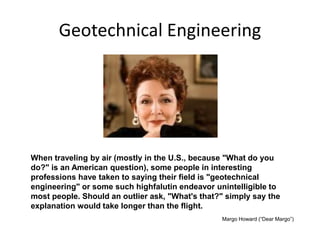The Ultimate Guide To Geotheta
The Ultimate Guide To Geotheta
Blog Article
Geotheta - Questions
Table of Contents9 Simple Techniques For GeothetaGeotheta - The FactsNot known Details About Geotheta Little Known Questions About Geotheta.
They work together with civil designers, architectural engineers, architects, and other professionals to incorporate geotechnical factors to consider right into the general task layout and construction procedure. This requires effective synergy, control, and communication to make sure that the geotechnical elements straighten with the job goals and meet regulatory requirements.Mining & Materials Engineering: Principles of drilling, infiltration rates, and variables influencing the selection of drilling technique. Characteristics of explosives, firing systems and blast patterns. Blowing up methods in surface area and below ground operations. Unique blowing up strategies at excavation boundaries. Resonance and noise control. Mechanical and continual strategies to fragmentation, consisting of longwall shearing and fullface boring.
Modelling of fragment and bit dimension circulations; comminution as a transfer feature. Comminution modern technology: squashing, grinding, size category. Integrated evaluation of fragmentation and comminution operations. Used by: Mining & Materials Engineering.
Geotheta - An Overview
Bachelor's level programs in civil, geotechnical, geological, and environmental engineering commonly last 4 years and consist of basic education and learning courses in English, social science, and the liberal arts, along with courses in advanced mathematics, structural geology, and fluid mineralogy. (https://filesharingtalk.com/members/599923-geotheta)
Geotechnical design includes the evaluation of the dirt and rock conditions at a particular site, and their implications for the development of that site. As a lot of structures depend on the ground for assistance, it lacks surprise that a thorough understanding of the ground problems, and the suitability of structure systems, are important to the long-term stability and efficiency of the building or structure.
Specialising in the investigation of geological developments and ground behavior, geotechnical engineers execute scientific examinations and testing to understand the influence these geological developments might have on the design and construction of building, civil and infrastructure tasks. This know-how is crucial for the design and building of structures, roadways, passages, dams, bridges, and water supply and sewer system.
The geotechnical group at Douglas Partners regularly talk to designers, layout designers, programmers, and home builders to make referrals on style and development proposals to guarantee that the developed frameworks are appropriately designed for the ground problems. The style of footing systems requires to think about the weight of the structure, the capability of the ground to support that weight together with motion resistances and reliable building.
Not known Factual Statements About Geotheta
This job is greatly simplified by the use our Douglas Map geospatial system that makes this info readily obtainable in an easy to utilize web browser user interface. A geotechnical engineer will route the boring of boreholes and test pits to collect dirt and other examples, and likewise evaluate surface area attributes and ground direct exposures to create a geotechnical version of the subsurface conditions.
Depending upon the task type redirected here and ground conditions ran into, research laboratory screening may to name a few points evaluate strength, compressibility, sensitivity and/or leaks in the structure of soil and rock examples. Hereafter information is accumulated and collated, the results are utilized for a geotechnical model of the website, which is normally offered as areas throughout the website.

A geotechnical examination by nature can only examine the ground problems at the areas drilled or dug deep into. Natural variations in soil and rock conditions can occur across a site and in between examination places. It is for that reason good practice that the geotechnical engineer be maintained throughout building and construction of the task to give on-site confirmation that the ground problems come across are constant with the assumptions and recommendations supplied in the geotechnical examination report.
What Does Geotheta Mean?
Geotechnical engineers use their comprehensive knowledge of dirt and rock to evaluate threat and fix troubles on varied framework projectsGeotechnical engineering is a specialist branch of civil design which considers the practices of planet materials and the application of soil and rock mechanics. Tailings Engineer. As a geotechnical designer, you will certainly examine the physical, mechanical and chemical properties of dirt and rock in order to design foundations, retaining frameworks and earthworks
Geotechnical design is very closely linked to and overlaps with, both design geology and ground engineering - https://www.pageorama.com/?p=geotheta. It's possible to be experts in geotechnics or benefit a geotechnical business yet be understood as a design geologist or a ground engineer. As a geotechnical designer, you'll require to: construct and maintain connections with customers and various other professionals associated with the website, throughout each projectmaintain security criteria on website be conscious of expense ramifications when you make recommendationsstudy geological maps and airborne photos from a variety of sources and from various time periodsexamine construction intends to see just how practical they are based upon your understanding of the siteinvestigate risks or geological dangers for the sitesearch for environmentally sensitive functions, such as land fill beginning to establish valid and interpretive ground modelsplan area investigationsdrill and evaluate samples of bedrock, dirt, groundwater and extra materials supervise other specialists on sitesolve technological issues as they arise, such as unexpected structures at drill sitesmonitor conditions during and after construction to see to it structures are steady in the brief and lengthy termadding data gathered on website to your preliminary researchcreating geotechnical estimations, illustrations, and 2 or three-dimensional computer system versions interpreting the datamaking referrals about the recommended use the website

Report this page